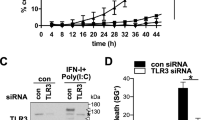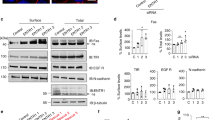Abstract
Ezrin links cortical actin filaments with the cell membrane, and has a critical role in many membrane-initiated events. Fas is directly associated with ezrin, but conflicting results have been reported for the involvement of ezrin in Fas-induced cell death. In this study we show that ezrin was associated with Fas in T cells before stimulation and was released shortly after Fas ligand (FasL) engagement. The knockdown of ezrin moderately increased Fas-triggered or tumor necrosis factor-related apoptosis-inducing ligand (TRAIL)-triggered cell death in normal T lymphocytes and in H9 cells, but had no effect on death receptor-induced apoptosis in type II cells, such as Jurkat and CEM. Expression of a dominant-negative form of ezrin also led to an increased Fas-induced apoptosis in H9 cells. Ezrin deficiency did not affect the internalization of Fas after Fas ligation. Instead, an enhanced formation of death-inducing signaling complex (DISC) was observed in H9 cells with ezrin knockdown, leading to accelerated caspase-8 activation. Together, our results suggest that ezrin has a negative role in the recruitment of Fas into signaling complexes in type I T cells. Loss of ezrin likely removes the constraint imposed by ezrin and facilitates the assembly of death receptor complex in T cells.
This is a preview of subscription content, access via your institution
Access options
Subscribe to this journal
Receive 50 print issues and online access
$259.00 per year
only $5.18 per issue
Buy this article
- Purchase on Springer Link
- Instant access to full article PDF
Prices may be subject to local taxes which are calculated during checkout







Similar content being viewed by others
Abbreviations
- DISC:
-
death-inducing signaling complex
- ERM:
-
ezrin, radixin and moesin
- FasL:
-
Fas ligand
- IS:
-
immunological synapse
- TRAIL:
-
tumor necrosis factor-related apoptosis-inducing ligand
References
Algeciras-Schimnich A, Shen L, Barnhart BC, Murmann AE, Burkhardt JK, Peter ME . (2002). Molecular ordering of the initial signaling events of CD95. Mol Cell Biol 22: 207–220.
Allenspach EJ, Cullinan P, Tong J, Tang Q, Tesciuba AG, Cannon JL et al. (2001). ERM-dependent movement of CD43 defines a novel protein complex distal to the immunological synapse. Immunity 15: 739–750.
Belkina NV, Liu Y, Hao JJ, Karasuyama H, Shaw S . (2009). LOK is a major ERM kinase in resting lymphocytes and regulates cytoskeletal rearrangement through ERM phosphorylation. Proc Natl Acad Sci USA 106: 4707–4712.
Bretscher A, Edwards K, Feho RG . (2002). ERM proteins and merlin: integrators at the cell cortex. Nat Rev Mol Cell Biol 3: 586–599.
Brown MJ, Nijhara R, Hallam JA, Gignac M, Yamada KM, Erlandsen SL et al. (2003). Chemokine stimulation of human peripheral blood T lymphocytes induces rapid dephosphorylation of ERM proteins, which facilitates loss of microvilli and polarization. Blood 102: 3890–3899.
Gautreau A, Louvard D, Arpin M . (2002). ERM proteins and NF2 tumor suppressor: the Yin and Yang of cortical actin organization and cell growth signaling. Curr Opin Cell Biol 14: 104–109.
Chakrabandhu K, Herincs Z, Huault S, Dost B, Peng L, Conchonaud F et al. (2007). Palmitoylation is required for efficient Fas cell death signaling. EMBO J 26: 209–220.
Chakrabandhu K, Huault S, Garmy N, Fantini J, Stebe E, Mailfert S et al. (2008). The extracellular glycosphingolipid-binding motif of Fas defines its internalization route, mode and outcome of signals upon activation by ligand. Cell Death Differ 15: 1824–1837.
Delon J, Kaibuchi K, Germain RN . (2001). Exclusion of CD43 from the immunological synapse is mediated by phosphorylation-regulated relocation of the cytoskeletal adaptor moesin. Immunity 15: 691–701.
Faure S, Salazar-Fontana LI, Semichon M, Tybulewicz VL, Bismuth G, Trautmann A et al. (2004). ERM proteins regulate cytoskeleton relaxation promoting T cell-APC conjugation. Nat Immunol 5: 272–279.
Feig C, Tchikov V, Schutze S, Peter ME . (2007). Palmitoylation of CD95 facilitates formation of SDS-stable receptor aggregates that initiate apoptosis signaling. EMBO J 26: 221–231.
Gupta N, Wollscheid B, Watts JD, Scheer B, Aebersold R, DeFranco AL . (2006). Quantitative proteomic analysis of B cell lipid rafts reveals that ezrin regulates antigen receptor-mediated lipid raft dynamics. Nat Immunol 7: 625–633.
Hao JJ, Liu Y, Kruhlak M, Debell KE, Rellahan BL, Shaw S . (2009). Phospholipase C-mediated hydrolysis of PIP2 releases ERM proteins from lymphocyte membrane. J Cell Biol 184: 451–462.
Hébert M, Potin S, Sebbagh M, Bertoglio J, Bréard J, Hamelin J . (2008). Rho-ROCK-dependent ezrin-radixin-moesin phosphorylation regulates Fas-mediated apoptosis in Jurkat cells. J Immunol 181: 5963–5973.
Kondo T, Takeuchi K, Doi Y, Yonemura S, Nagata S, Tsukita S . (1997). ERM (ezrin/radixin/moesin)-based molecular mechanism of microvillar breakdown at an early stage of apoptosis. J Cell Biol 139: 749–758.
Kulms D, Düssmann H, Pöppelmann B, Ständer S, Schwarz A, Schwarz T . (2002). Apoptosis induced by disruption of the actin cytoskeleton is mediated via activation of CD95 (Fas/APO-1). Cell Death Differ 9: 598–608.
Ilani T, Khanna C, Zhou M, Veenstra TD, Bretscher A . (2007). Immune synapse formation requires ZAP-70 recruitment by ezrin and CD43 removal by moesin. J Cell Biol 179: 733–746.
Lee KH, Feig C, Tchikov V, Schickel R, Hallas C, Schutze S et al. (2006). The role of receptor internalization in CD95 signaling. EMBO J 25: 1009–1023.
Li Y, Harada T, Juang YT, Kyttaris VC, Wang Y, Zidanic M et al. (2007). Phosphorylated ERM is responsible for increased T cell polarization, adhesion, and migration in patients with systemic lupus erythematosus. J Immunol 178: 1938–1947.
Lozupone F, Lugini L, Matarrese P, Luciani F, Federici C, Iessi E et al. (2004). Identification and relevance of the CD95-binding domain in the N-terminal region of ezrin. J Biol Chem 279: 9199–9207.
Mrass P, Kinjyo I, Ng LG, Reiner SL, Puré E, Weninger W . (2008). CD44 mediates successful interstitial navigation by killer T cells and enables efficient antitumor immunity. Immunity 29: 971–985.
Nagata S . (1997). Apoptosis by death factor. Cell 88: 355–365.
Niggli V, Rossy J . (2008). Ezrin/radixin/moesin: versatile controllers of signaling molecules and of the cortical cytoskeleton. Int J Biochem Cell Biol 40: 344–349.
Parlato S, Giammarioli AM, Logozzi M, Lozupone F, Matarrese P, Luciani F et al. (2000). CD95 (APO-1/Fas) linkage to the actin cytoskeleton through ezrin in human T lymphocytes: a novel regulatory mechanism of the CD95 apoptotic pathway. EMBO J 19: 5123–5134.
Peter ME, Budd RC, Desbarats J, Hedrick SM, Hueber AO, Newell MK et al. (2007). The CD95 receptor: apoptosis revisited. Cell 129: 447–450.
Peter ME, Krammer PH . (2003). The CD95 (APO-1/Fas) DISC and beyond. Cell Death Differ 10: 26–36.
Piazzolla D, Meissl K, Kucerova L, Rubiolo C, Baccarini M . (2005). Raf-1 sets the threshold of Fas sensitivity by modulating Rok-alpha signaling. J Cell Biol 171: 1013–1022.
Ramaswamy M, Dumont C, Cruz AC, Muppidi JR, Gomez TS, Billadeau DD et al. (2007). Rac GTPases sensitize activated T cells to die via Fas. J Immunol 179: 6384–6388.
Roumier A, Olivo-Marin JC, Arpin M, Michel F, Martin M, Mangeat P et al. (2001). The membrane-microfilament linker ezrin is involved in the formation of the immunological synapse and in T cell activation. Immunity 15: 715–728.
Scaffidi C, Fulda S, Srinivasan A, Li F, Tomaselli KJ, Debatin KM et al. (1998). Two CD95 (APO-1/Fas) signaling pathways. EMBO J 17: 1675–1687.
Shaffer MH, Dupree RS, Zhu P, Saotome I, Schmidt RF, McClatchey AI et al. (2009). Ezrin and moesin function together to promote T cell activation. J Immunol 182: 1021–1032.
Shcherbina A, Bretscher A, Kenney DM, Remold-O'Donnell E . (1999). Moesin, the major ERM protein of lymphocytes and platelets, differs from ezrin in its insensitivity to calpain. FEBS Lett 443: 31–36.
Strasser A, Jost PJ, Nagata S . (2009). The many roles of FAS receptor signaling in the immune system. Immunity 30: 180–192.
Acknowledgements
This work was supported by Grant NHRI-EX96–9527NI from National Health Research Institute, NSC 95–2320-B001–023 from National Science Council and an Academia Sinica Investigator Award from Academia Sinica, Taiwan, ROC. We thank Drs I-Chen Ho, Gina Costa and Garry Nolan for critical reagents, Yamin Lin and FACS Core of Institute of Molecular Biology, Academia Sinica for cell sorting and Dr Harry Wilson for editing this paper.
Author information
Authors and Affiliations
Corresponding author
Additional information
Supplementary Information accompanies the paper on the Oncogene website (http://www.nature.com/onc)
Supplementary information
Rights and permissions
About this article
Cite this article
Kuo, WC., Yang, KT., Hsieh, SL. et al. Ezrin is a negative regulator of death receptor-induced apoptosis. Oncogene 29, 1374–1383 (2010). https://doi.org/10.1038/onc.2009.417
Received:
Revised:
Accepted:
Published:
Issue Date:
DOI: https://doi.org/10.1038/onc.2009.417
Keywords
This article is cited by
-
Myocardial proteomic profile in pulmonary arterial hypertension
Scientific Reports (2020)
-
Organelle-specific initiation of cell death
Nature Cell Biology (2014)
-
Akt/Ezrin Tyr353/NF-κB pathway regulates EGF-induced EMT and metastasis in tongue squamous cell carcinoma
British Journal of Cancer (2014)
-
Differential protein expression associated with photodynamic therapy using chlorin e6
Molecular & Cellular Toxicology (2014)
-
Ezrin dephosphorylation/downregulation contributes to ursolic acid-mediated cell death in human leukemia cells
Blood Cancer Journal (2013)



